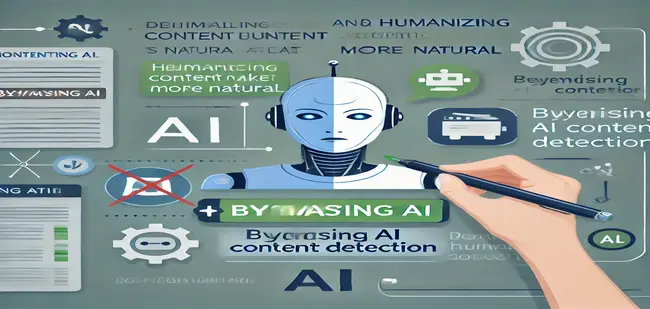Bypass AI Content Detection

Overview :
Bypassing AI content detection involves “humanizing” AI-generated text to evade algorithms that flag automated content. Techniques include rephrasing and adding unique phrasing to reduce patterns typical of AI. These adjustments aim to make the text more authentic and avoid plagiarism detection while retaining content originality.
Tags: AI Content Detection AI Content Generation Bypass AI content detection
Free Tutorials
AI Content Generation
AI Content Generation
AI content generation refers to the use of artificial intelligence to create written, visual, or multimedia content. By leveraging advanced algorithms and natural language processing, AI tools can draft articles, generate marketing copy, create visuals, and even develop scripts with minimal human input. This technology is increasingly valuable for businesses, content creators, and marketers to produce consistent, tailored content efficiently.
AI Content Generation Tools
ChatGPT: A versatile language model by OpenAI that generates text, assists with ideas, and can even write entire articles and scripts based on prompts.
Jasper.ai: Ideal for marketing, Jasper.ai specializes in creating engaging copy for blogs, ads, and social media posts, tailored to brand tone.
Writesonic: Writesonic offers AI-powered text generation for a range of content types, including SEO-optimized blog posts, emails, and ads.
Copy.ai: Focused on marketing content, Copy.ai helps users craft product descriptions, social media content, and ad copy.
Article Forge: This tool generates unique, high-quality articles on various topics, targeting SEO-friendly content for website publishers.
Rytr: A budget-friendly AI tool for writing emails, blog posts, and even business pitches with customizable tones and styles.
Canva’s Magic Write: Integrated into Canva’s design platform, Magic Write generates short text for social posts, presentations, and visual projects.
CopySmith: Designed for e-commerce, CopySmith helps create product descriptions, ad copy, and content tailored for online retail platforms.
These tools are widely used across industries for content creation, streamlining workflows, and enhancing productivity.
AI Content Detection
AI Content Detection
AI content detection identifies content created by artificial intelligence, distinguishing it from human-generated text. By analyzing language patterns, phrasing, and structural elements typical of AI, these tools help verify content authenticity. They’re particularly useful for educators, publishers, and businesses to ensure originality and maintain content integrity.
AI Content Detection Tools
Turnitin AI Detection: Primarily used in educational settings, Turnitin’s AI detection tool flags AI-written text in student submissions, helping maintain academic integrity.
Originality.ai: Tailored for content publishers, Originality.ai identifies both plagiarism and AI-generated text, ensuring high standards of content authenticity.
Copyleaks AI Detector: Designed for academic and professional use, Copyleaks accurately detects AI-generated text in assignments, essays, and articles.
GPTZero: An accessible tool developed for teachers and students, GPTZero checks text for AI-generated patterns, especially from large language models like GPT.
OpenAI’s AI Text Classifier: OpenAI’s own tool for identifying AI-generated text, useful for general-purpose content verification in various domains.
Sapling.ai: This detector flags AI-generated content while providing grammar and style checks, supporting content review and compliance in business contexts.
Hive Moderation: A versatile tool, Hive Moderation detects AI text, as well as unsafe content, making it popular in moderation for social platforms.
ZeroGPT: Free to use, ZeroGPT focuses on identifying text generated by large language models, helping users assess content originality.
These tools are integral in sectors where verifying the authenticity of content is crucial, offering varied approaches to detecting AI-generated text.
Bypass AI Content Detectoin
Bypassing AI content detection
Bypassing AI content detection refers to techniques and tools designed to help users generate or modify content in such a way that it avoids detection by AI content detection systems. These systems are used to identify whether a piece of writing is created by a human or generated by an AI model. The need for bypassing such detection often arises in educational and professional contexts, where users aim to ensure their work meets originality standards without compromising on quality. Effective bypassing methods may involve paraphrasing, altering sentence structure, and using synonym substitution to make AI-generated content more human-like.
Popular Bypass AI Content Detection Tools
bypass.ai: A versatile tool designed to rephrase text, ensuring the output is unique and less detectable by AI systems.
cloakify.ai: Utilizes advanced algorithms to disguise content, making it appear original and avoiding detection.
slywrite.ai: Enhances written content with smart rephrasing suggestions, allowing for varied expression and reducing the risk of being flagged.
maskit.ai: A user-friendly platform that alters sentences to create unique versions of existing text, aiding in originality.
shadowtext.ai: Focuses on rewording and paraphrasing to create content that blends seamlessly with human writing styles.
veilgen.ai: An AI tool that generates complete articles while mimicking human writing patterns, effectively bypassing detection mechanisms.
hushcontent.ai: Generates unique articles from prompts, minimizing the likelihood of being detected by AI detection systems.
cipherwrite.ai: A grammar-focused tool that also provides rewriting options to ensure content appears fresh and original.
Free Tutorials
References of initial studies from other authors and publishers are given here. We follow international standards in writing unbiased content.
Affiliate Disclosure
We maintain a transparent culture in our work and do-follow FTC affiliate disclosure guidelines. This blog post might include affiliate web links, which implies we might obtain a commission if you click a web link and buy some product or service that we suggested.











 Master AI tools like ChatGPT, Canva, Grammarly, vidIQ & tubebuddy.
Master AI tools like ChatGPT, Canva, Grammarly, vidIQ & tubebuddy.